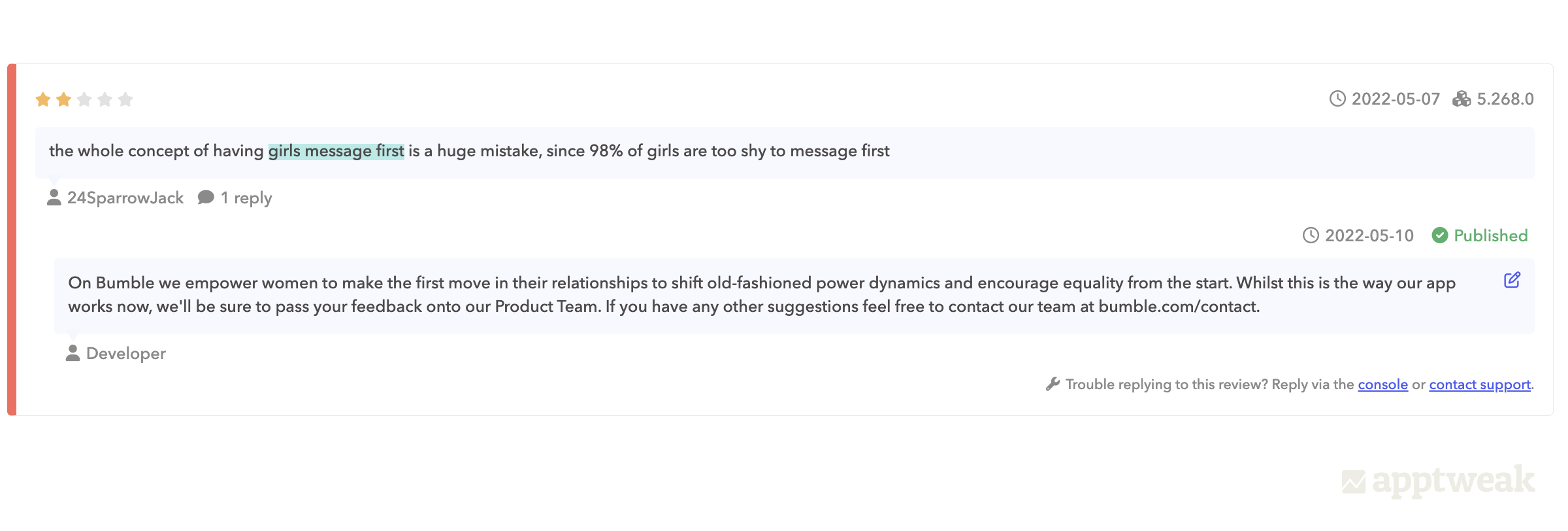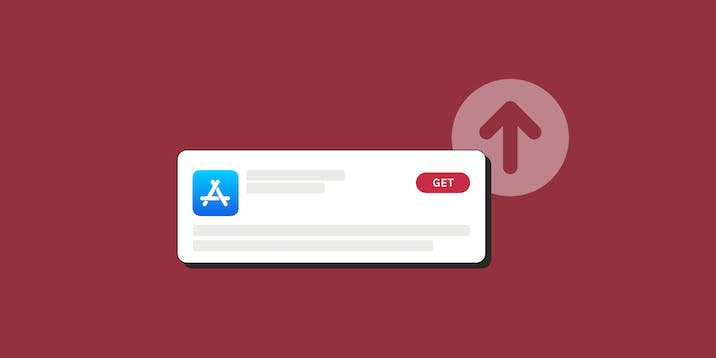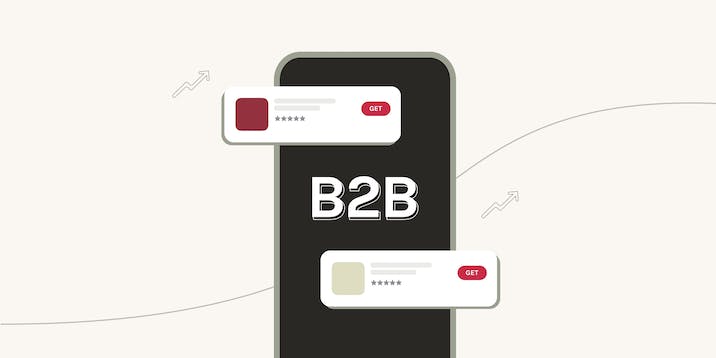
Why & How to Reply to App Store Reviews
Reviews & ratings play a major role in app conversion, and can have a strong impact on your app’s daily installs. According to a study conducted by Apptentive, 79% of consumers check ratings and reviews before downloading an app. So, what can you do to take control of your reviews? And how can you do this on AppTweak?
This blog will cover the importance of replying to reviews and highlight tips and tricks to help you improve your average score. We will also help you reply to different types of app reviews, drawing on real examples from leading apps.
Looking for a complete solution to manage and reply to your app store reviews? You no longer need to go back and forth between consoles. With Review Management by AppTweak, save time replying to your users with our review management and automation tools.
Learn more about AppTweak’s Review Management powered by GPT-4
Reviews & ratings on the app stores
On the App Store, ratings appear:
- In the search results under the title and subtitle
- On the app page, in the information panel
- Further down your app page, underneath the description and developer name
On Google Play, ratings appear:
- Underneath the title and short description in multiple featurings throughout the Play Store
- Underneath the title and Google tags in the search results
- On the app page, in the information panel
- Further down your app page, underneath the Data safety section
On both app stores, reviews appear only on the app page.
Importance of replying to app store reviews
The most important thing to keep in mind is that reviews and ratings are a great source of feedback. Frequently going through your app’s reviews can give you a better understanding of your customers’ experiences using your product, providing a closer look at their wants and needs.
Reviews can also help you identify your strongest features or areas for improvement. To broaden your analysis even further, you can take a look at your competitors’ reviews for a comparative vision. We would recommend that you leverage every key insight you can find and share them with your product team for future tool improvements. With the rise of AI and Chat GPT-4, you can easily and quickly identify the main user topics of your reviews.

So, why should you reply to your app store reviews?
- First, replying to app store reviews is important to maintain a strong relationship with your users. It is a known fact that giving your consumers extra time and attention won’t go to waste and will be appreciated.
- There is always the possibility that the right reply will convince any unhappy users to change their rating and have an indirect impact on your average score.
Discover how ratings and reviews can positively (or negatively) impact your app visibility
Best practices: Replying to app store reviews
1. Prioritize
If your resources (time, effort, employees) are limited, it is recommended that you first prioritize replying to reviews with the lowest star ratings before engaging with positive reviews. On AppTweak, this process is made even easier by being able to filter your reviews by average star rating. Also, keep in mind that the faster you reply to reviews, the better!
2. Personalize
Nobody likes automatic responses; people enjoy being heard. As such, try to give users a personalized reply by mentioning their store nickname, for example. This is also a great opportunity to use your brand’s tone of voice to showcase your culture and values.
3. Recognize
When it comes to negative reviews, you can start by acknowledging the users’ issues and letting them know that you are working on fixing them. Once the app has been updated to resolve the issue, go back to your old reply and announce the fix. This might even encourage the user to change their mind and give you a better rating.
Learn how to efficiently manage your reviews and ratings
Strategies to minimize negative app reviews
1. App review prompts
A great strategy to minimize negative reviews is to employ in-app prompts that ask users for their feedback at an optimal time. To do so, you should identify moments in your user experience whereusers are most likely to be satisfied with the app. For example, this could be after overcoming a challenge or successfully passing a game level.
Be careful – do not interrupt the user and ask for feedback too soon or at the wrong time, such as during their onboarding. Additionally, make sure to not repeat the prompt in a manner that irritates users.
2. Highlight your most positive reviews
You should definitely try to ensure your best app reviews have the most visibility on the app stores. To do this, you need to understand the procedure behind featured reviews on both the App Store and Google Play:
- On the App Store, featured reviews are the first 6 reviews in the “Most Helpful” section. These are the reviews with themost upvotes from other users or from your own team. As a result, have your employees upvote 2 or 3 positive reviews to boost these to the top of the store!
- On Google Play, featured reviews may appear as “most relevant” or “most recent” depending on users. “Most recent” featured reviews simply show the last 3 reviews published, whereas “most relevant” reviews are picked by Google’s algorithm. Google has not disclosed what criteria matter for that algorithm, but based on our observations, they are probably picked among reviews published in the last 3 months, in the same locale as the user (remember that while Play Store ratings are global until November 2021, reviews are localized), and based on the length and number of keywords associated with a specific topic included in the review.
3. Include contact details
Another strategy to help minimize your negative reviews is to inform users that they can directly reach you by email or other methods. By adding contact details (e.g. email address) to your app’s long description, not only do you show you are receptive to feedback, you also provide your customers with a way to raise issues directly with your team instead of publicly on the store.
Discover what happened to Robinhood when it received 220K negative reviews in just one hour
Replying to different types of app reviews
Using AppTweak’s Reviews & Ratings section, we found some apps that have good examples of how to reply to negative or positive reviews and engage with users. We grouped these replies based on the type of user or situation that any app could face.
The aggressive user
When receiving aggressive reviews, even though you might not share the user’s opinion, it is important to show compassion by adopting a pleasant tone of voice. Sharing your app’s contact details to provide further support shows you are open to discussion and actively trying to improve your customers’ journey.
Here are some examples of how Bumble has dealt with such replies:

Having frustrated users like the one below is actually good for Bumble. Even though they probably already lost this particular customer, replying to their review is an opportunity to recall their mission and engage curious store listing visitors.

The big supporter
Even though replying to bad reviews remains the priority, answering fans will show how much you care about them. At the same time, it puts your app under the spotlight. In this example, Bumble goes one step further by engaging a user with its community.

In AppTweak’s Reviews & Ratings section, you can filter reviews by keyword (as we did here) when searching for positive reviews, helping you better understand what is the sentiment of reviewers for specific keywords.
Re-engaging frustrated users
When dealing with complaints regarding technical aspects of your app, you should show your app users compassion and support.

Too Good To Go’s reply to a customer complaint is another good example of dealing with bad reviews. Instead of simply sharing the contact details of the customer support service, they directly attempt to solve the customer’s issue. When store users see that your app provides relevant and personalized feedback, they will definitely be reassured, which will help drive conversion.

Encourage users to update their comment & rating
The following example illustrates how valuing users’ reviews and showing them support can actually drive users to change their ratings.
It’s interesting to see that Brave has a quite straightforward and familiar way of communicating with its users. Instead of including long forms of address, Brave has a very natural and authentic way of communicating. You can feel they are not simply copy-pasting answers that have already been prepared.

In another example, we see Floreaching directly out to the customer to point out their “3 stars.” It may be a good strategy to outline the rating the user gave in your reply, so that once the user reads your reply, they may consider changing it if the problem has been solved.

3 steps to reply to your app reviews for iOS or Android
1. Read your reviews
Going through your app reviews can be very time-consuming. However, you have to do this to get to know your users. Especially, if you want to prepare some templated replies, you will need to read reviews to identify common complaints/behaviors.
2. Prepare “template sentences” for each situation
Even though applying template replies can save time, you’d rather have authentic and personal replies than neutral and repetitive ones.
We recommend preparing “template sentences” and associating them with a tag so that you can directly copy-paste some sentences based on the context.
When applying template replies, make sure to read the whole review, making sure all details are correct and relevant before pasting your answer.

3. Update your reply once a problem has been fixed
You can filter reviews with a keyword commonly shared among users complaining about a bug. That way, you will be able to update users once the issue has been fixed and try to re-engage them.
More tips on how to respond to good and bad app reviews
How to manage & reply to app reviews on AppTweak
Save time and effort replying to your app reviews directly from AppTweak. Powered by GPT-4, our Review Management tool is a complete solution to help you manage app store reviews and increase efficiency when replying to your users. With 50 replies automatically included with an AppTweak plan, just connect your console to get started leveraging our incredible range of review management features:
- Reply to your reviews across apps, stores, countries, and languages
- Boost agent productivity with GPT-4 reply suggestions (in any language), bulk reply, templates & tags
- Increase efficiency using our Zendesk, Slack & Salesforce integrations
- Improve your team’s organization with filters & saved views, and auto-translate
- Understand reply impact by monitoring history, upvotes/downvotes & KPIs
- And more.

Start managing your reviews efficiently with AppTweak’s Review Management Tool
Final thoughts
Replying to reviews on the App Store and Google Play is a great way to acknowledge valuable feedback from your consumers, maintain a strong relationship with your users, and convince unhappy users to change a negative rating.
To optimize your review strategy on the stores, try to:
- Prioritize your resources to reply to the most negative reviews first
- Personalize your replies and use your brand’s tone of voice to showcase your culture and values
- Recognize users’ issues and let them know that you are working on fixing them
- Make strategic use of in-app review prompts
- Highlight your most positive reviews if possible
- Include your contact details in your long description, providing users with a direct line to give you feedback
Get 50 replies for our powerful Review Management tool automatically included in your AppTweak plan.



 Emily Sugrue
Emily Sugrue
 Mariia Chernoplyokova
Mariia Chernoplyokova


 Sarah B. Touimi
Sarah B. Touimi
 Yuliya Tsimokhava
Yuliya Tsimokhava